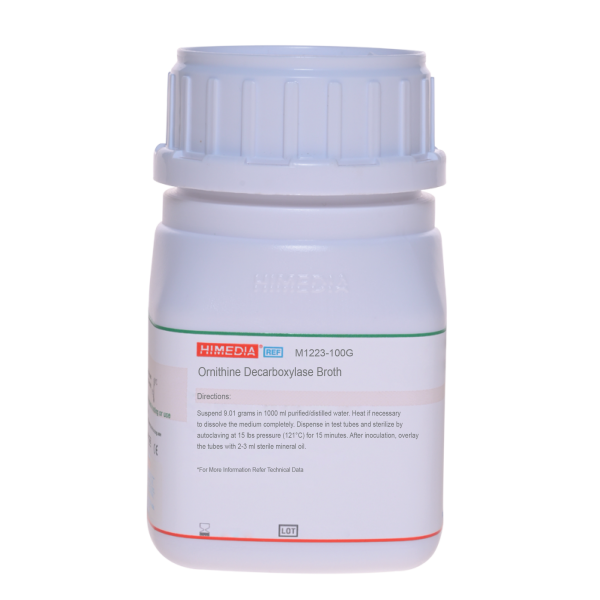 Your enquiry has been submitted
Your enquiry has been submitted
Ornithine Decarboxylase Broth
Ornithine Decarboxylase Broth is recommended for detection of the ability of microorganisms to decarboxylate ornithine.
Composition**
| Ingredients | Gms / Litre |
|---|---|
| L-Ornithine monohydrochloride | 5.000 |
| Yeast extract | 3.000 |
| Glucose | 1.000 |
| Bromo cresol purple | 0.015 |
Final pH (at 25°C): 6.8±0.2
**Formula adjusted, standardized to suit performance parameters
Directions
Suspend 9.01 grams in 1000 ml distilled water. Heat if necessary to dissolve the medium completely. Dispense in test tubes and sterilize by autoclaving at 15 lbs pressure (121°C) for 15 minutes. After inoculation overlay the tubes with 2-3 ml mineral oil.
Principle And Interpretation
Decarboxylation is the process in which bacteria that possess specific decarboxylase enzyme attack amino acids at their carboxyl end (-COOH) to yield an amine or a diamine and carbon dioxide (1). The amino acid L-ornithine is decarboxylated by the enzyme ornithine decarboxylase to yield the diamine putrescine and carbon dioxide (2, 3).
Ornithine Decarboxylase Broth is based on the Taylors modification (4). It is recommended by the ISO Committee (5) for the detection of ornithine decarboxylation by Yersinia enterocolitica
Yeast extract in the medium provides nitrogen and other nutrients necessary to support bacterial growth. The amino acid ornithine is added to detect the production of ornithine decarboxylase. Glucose is the fermentable carbohydrate, which during the initial stages of incubation, is fermented by the organisms with acid production, which results in colour change of the pH indicator (BCP) to yellow. The acidic condition also stimulates decarboxylase activity. If the organism produces the appropriate enzyme, i.e. decarboxylase, the amino acid (ornithine) in the medium is degraded, yielding a corresponding amine. Decarboxylation of ornithine yields putrescine. The production of this amine elevates the pH of the medium towards alkalinity, changing the color of the indicator from yellow to purple or violet. If the organism does not produce the appropriate enzyme, the medium remains acidic or yellow in colour.
Quality Control
Appearance: Light yellow to light green homogeneous free flowing powder
Colour and Clarity of prepared medium: Dark purple coloured clear solution without any precipitae
Reaction: Reaction of 0.9% aqueous solution at 25°C. pH: 6.8±0.2
pH: 6.60-7.00
Cultural Response
M1223: Cultural characteristics observed after an incubation at 35-37°C for 18-24 hours. Inoculated tubes are overlayed with mineral oil.
| Organism | Inoculum (CFU) | Ornithine Decarboxylation |
|---|---|---|
| Escherichia coli ATCC 25922 | 50-100 | variable reaction |
| Enterobacter aerogenes ATCC 13048 | 50-100 | positive reaction, purple colour |
| Klebsiella pneumoniae ATCC 13883 | 50-100 | negative reaction, yellow colour |
| Proteus mirabilis ATCC 25933 | 50-100 | negative reaction, yellow colour |
| Proteus vulgaris ATCC 13315 | 50-100 | positive reaction, purple colour |
| Salmonella Paratyphi A ATCC 9150 | 50-100 | positive reaction, purple colour |
| Salmonella Typhi ATCC 6539 | 50-100 | negative reaction, yellow colour |
| Shigella flexneri ATCC 12022 | 50-100 | negative reaction, yellow colour |
| Shigella sonnei ATCC 25931 | 50-100 | positive reaction, purple colour |
| Yersinia enterocolitica ATCC 27729 | 50-100 | positive reaction, purple colour |
Storage and Shelf Life
Store below 30°C in tightly closed container and the prepared medium at 2 - 8°C. Use before expiry date on the label.
Reference
- Smith D.T., Coant N.F., Willett H.P., Zinssers Microbiology, 14th Ed., New York: Appleton-Century-Crofts, 1968:118-119
- Moeller V., 1955, Acta Pathol. Microbiol. Scand. 36 (2): 158-172
- MacFaddin J.F., 2000, Biochemical Tests for Identification of Medical Bacteria, 3rd Ed., Lippincott, Williams and Wilkins, Baltimore.
- Taylor W.I., 1961, Appl. Microbiol., 9:487.
- International Organization for Standardization (ISO), 1994, Draft ISO/DIS 10273.
| Product Name | Ornithine Decarboxylase Broth |
|---|---|
| SKU | M1223 |
| Product Type | Regular |
| Physical Form | Powder |
| Origin | Animal Free (Microbial) |
| Packaging type | HDPE |
| References | 1.Smith D.T., Coant N.F., Willett H.P., Zinssers Microbiology, 14th Ed., New York: Appleton-Century-Crofts, 1968:118-1192.Moeller V., 1955, Acta Pathol. Microbiol. Scand. 36 (2): 158-1723.MacFaddin J.F., 2000, Biochemical Tests for Identification of Medical Bacteria, 3rd Ed., Lippincott, Williams and Wilkins,Baltimore.4.Taylor W.I., 1961, Appl. Microbiol., 9:487.5.International Organization for Standardization (ISO), 1994, Draft ISO/DIS 10273. |
| Customized Product Available | No |






